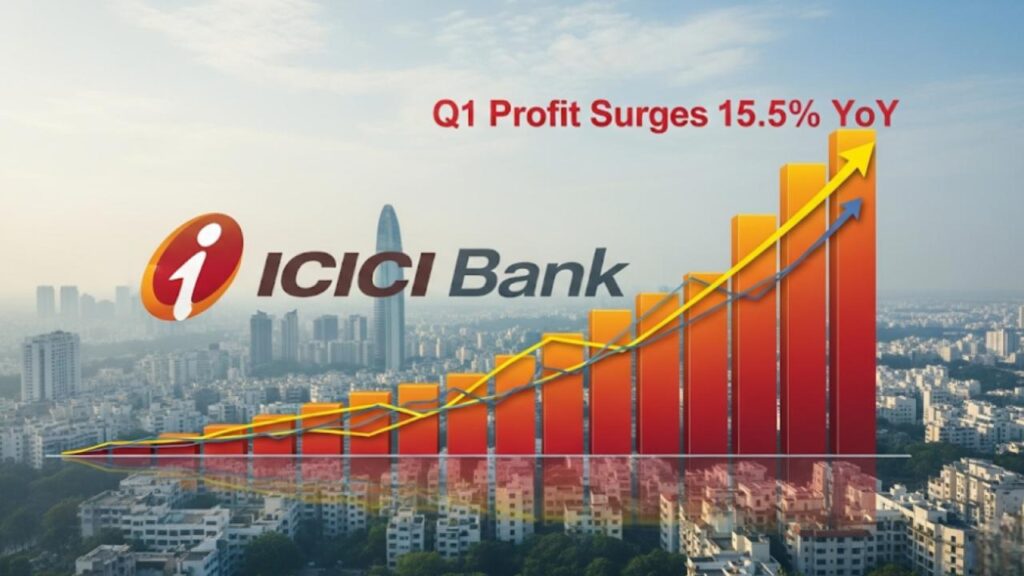ICICI Bank, one of India’s leading private-sector banks, recently announced its Q1 results for FY26, reporting a remarkable 15.5% growth in its net profit, bringing the total to ₹12,768 crore. This impressive performance is the culmination of several key factors—strong loan growth, efficient risk management, strategic digital investments, and a diversified business model.

ICICI Bank Q1 Profit Surges 15.5% YoY to ₹12,768 Cr
| Key Metric | Q1 FY26 Performance | Year-on-Year Change |
|---|---|---|
| Net Profit | ₹12,768 Cr | +15.5% |
| Net Interest Income | ₹21,635 Cr | +10.6% |
| Gross NPA Ratio | 1.67% | Improved from 2.15% |
| Digital Transactions | 70% of trade transactions are digitized | +51.6% in UPI transactions |
| Total Advances | ₹13.64 lakh Cr | +11.5% |
ICICI Bank’s Q1 FY26 results reflect a story of strong, diversified growth. With 15.5% profit growth, steady loan book expansion, a focus on digital banking, and strategic acquisitions, ICICI Bank has laid a solid foundation for sustained growth. Despite challenges like interest rate pressures and global economic uncertainty, the bank’s ability to adapt and innovate ensures its place as a leader in India’s banking sector.
The Fuel Behind ICICI Bank’s Q1 Growth
1. Strong Loan Growth
One of the primary drivers behind ICICI Bank’s solid Q1 performance has been the robust growth in its loan book. The bank’s total advances grew by 11.5% year-on-year (YoY), amounting to a whopping ₹13.64 lakh crore.
- Retail Loans: These continue to be a significant contributor, accounting for 52.2% of the total loan book. With a YoY growth rate of 6.9%, retail loans, including personal loans, home loans, and auto loans, have helped ICICI Bank cater to India’s growing middle class.
- Corporate Loans: Corporate loans also performed well, expanding by 7.5% YoY. This indicates strong demand from businesses looking for credit to fuel their growth and operations, particularly in sectors like infrastructure, manufacturing, and services.
- Business Banking: A standout performer has been the business banking segment, which saw a stellar 29.7% growth YoY. Small and medium-sized enterprises (SMEs) are increasingly turning to ICICI Bank for financing, reflecting a robust economic recovery.
This diversified loan portfolio, along with growing demand across sectors, showcases ICICI Bank’s capacity to adapt to changing economic conditions while maintaining a balanced risk profile.
2. Core Lending Income and Net Interest Income (NII)
ICICI Bank’s Net Interest Income (NII), a critical indicator of a bank’s profitability, rose by 10.6% YoY to ₹21,635 crore. The bank benefited from higher loan disbursements and interest income from its vast retail and corporate lending portfolios. However, the Net Interest Margin (NIM)—the difference between what the bank earns from its loans and what it pays on deposits—slightly dipped to 4.34%, down from 4.41% in the previous quarter. This decline can be attributed to the Reserve Bank of India’s (RBI) interest rate cuts.
Despite the NIM pressure, the solid growth in loan volumes and increased retail banking activity helped offset the margin contraction, making ICICI Bank’s core lending operations a key contributor to the bank’s bottom line.
3. Asset Quality: A Focus on Risk Management
A critical factor in maintaining sustainable growth is effective risk management. ICICI Bank has demonstrated prudent financial practices in managing its asset quality. The bank reported a gross NPA (non-performing asset) ratio of 1.67%, significantly improved from 2.15% a year ago.
- Net NPA: The net NPA ratio also showed improvement, decreasing to 0.41% from 0.43% in Q1 FY25.
- Provisions: ICICI Bank has made provisions of ₹1,815 crore in the quarter, compared to ₹1,332 crore in the previous year, ensuring that it remains well-capitalized to handle any potential asset quality issues down the road.
This emphasis on maintaining healthy asset quality through provisioning and vigilant risk management has contributed to ICICI Bank’s resilience in the face of challenging macroeconomic conditions.
4. Digital Transformation and Technology Investments
In today’s world, digital transformation isn’t just a trend—it’s a necessity. ICICI Bank has successfully capitalized on the rapid digitalization of financial services. Over 70% of its trade transactions are now digitized, and its UPI merchant acquiring transactions saw a 51.6% YoY increase.
The bank’s strategic investments in digital banking platforms and AI-driven financial tools have helped enhance customer experience and streamline operations. For instance, the Insta Credit Card, launched in partnership with Visa and powered by AI, allows customers to get a credit card instantly, making banking more accessible for a tech-savvy generation.
By leveraging technology, ICICI Bank has positioned itself as a leader in digital banking, further expanding its customer base while reducing operational costs.
5. Capital Adequacy: Strong and Stable
ICICI Bank continues to maintain a strong capital adequacy ratio of 16.97%, with its Common Equity Tier-1 (CET1) ratio standing at 16.31%. These figures indicate that the bank is well-capitalized to absorb shocks and support continued growth. A robust capital position is essential for managing risks and funding further expansion, especially as the bank continues to increase its lending and diversify its offerings.
6. Strategic Acquisitions and Partnerships
Another important factor contributing to ICICI Bank’s growth is its focus on strategic acquisitions. The bank recently announced plans to acquire ICICI Prudential Pension Funds Management Company to further strengthen its foothold in the pension fund management space. This acquisition is expected to create synergies between ICICI Bank’s existing wealth management and insurance offerings, enhancing its ability to serve a broader range of customers.
This move is part of ICICI Bank’s long-term strategy to diversify its revenue streams and provide comprehensive financial solutions to individuals and businesses alike.
FAQs
Q1: What is the reason behind ICICI Bank’s 15.5% profit growth in Q1 FY26?
ICICI Bank’s 15.5% profit growth was driven by strong loan growth, improved asset quality, increased digital transactions, and strategic investments in technology. Additionally, prudent risk management and a diversified loan book also contributed significantly to the growth.
Q2: How did ICICI Bank manage its asset quality amid economic challenges?
ICICI Bank maintained a solid asset quality by improving its NPA ratios and increasing provisions to safeguard against potential defaults. The gross NPA ratio improved to 1.67%, and the net NPA ratio decreased to 0.41%.
Q3: How does ICICI Bank’s digital transformation contribute to its success?
ICICI Bank has successfully digitized over 70% of its trade transactions and has seen a significant increase in UPI merchant transactions. Investments in AI-powered tools, such as the Insta Credit Card, have enhanced customer experience, attracting more tech-savvy users.
Q4: What are ICICI Bank’s plans for future growth?
ICICI Bank plans to expand its reach by further investing in digital technologies, diversifying its business portfolio, and leveraging acquisitions like the purchase of ICICI Prudential Pension Funds Management Company. The bank is also focused on improving its customer base and market position in various financial sectors.








